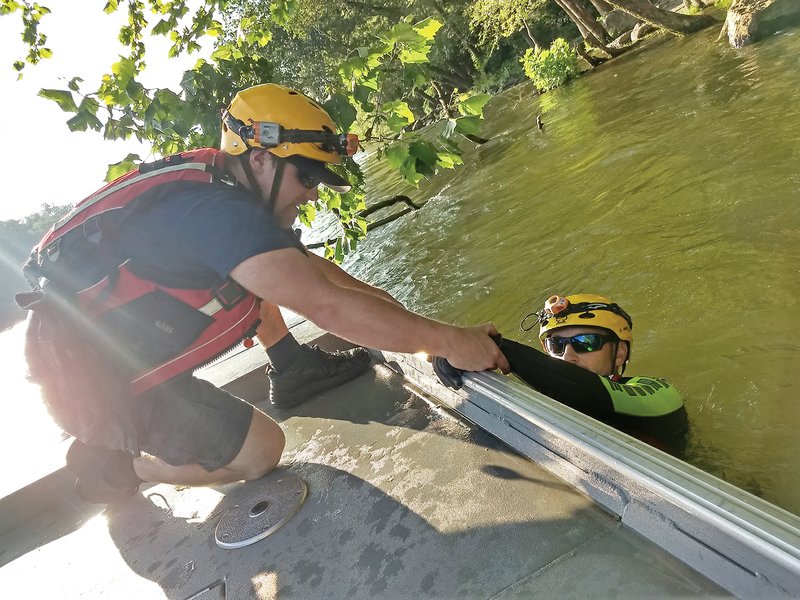MALVERN — As many people use the Ouachita River for boating, fishing and inner-tubing, special personnel with the Malvern Fire Department train for water rescues.
Summertime is the season for water-related accidents and safety incidents. A particular point of interest along the river is Rockport Ledge, which features partially raised boulders and rocks — great obstacles for kayaking. The site has even been known to host U.S. Olympians seeking training with eddies and other currents.
But the rocky ledge — coupled with the regular rise and fall of water levels along the river — can create danger to unsuspecting recreationalists.
“You never know what kind of a situation you’ll have to go into,” said Lt. Tanner Neighbors of the Malvern Fire Department, a rescue trainee. “We have to master the best option.”
Neighbors is one of a handful of trainees who are receiving hands-on instruction for rescuing accident victims in rescue boats this summer. Leading the group is Johnny Farber, a battalion and training chief for the department. He said educating the trainees is only half his job; the other half is teaching them how to rescue victims who — because of fear and adrenaline — are difficult to save.
“Sometimes, they are so scared, they’re like a raccoon that wants to jump on you and sink [you],” Farber said.
Farber calls out detailed instructions to trainees on how they’re to communicate with the accident victim, how to position themselves, how to maintain control. He also speaks with the boat driver. While moving against the water current, the driver must move the vessel alongside the incident scene so the rescuer can connect with the accident victim.
RISING TIDE
In other situations, people enjoying the outdoors wade out into the river when the water level is low. Sometimes, the water gets so low that it creates river islands. But water levels downstream from Remmel Dam, which holds Lake Catherine, can change suddenly.
“People who aren’t aware of their surroundings often get carried away by the sudden rise and fall of water levels,” Farber said.
As Farber recalls, some level changes can be catastrophic. During a rainy April season two years ago, rainfall vaulted the normal dam output of 4,000 cubic feet per second to 50,000 cubic feet per second, he said. River levels jumped as much as 5 to 6 feet.
This kind of output was bad news for one camper who was sleeping near the dam. Water levels were enough to push him into a tree and leave him stuck there when water levels receded, Farber said.
“He was up 10 to 15 feet from where he’d been,” Farber said. “Water was all around him. We rescued him finally and got him in the boat. I don’t know how long he was [in the tree].”
Emergency calls for the rescue squad occur at random times at all hours. The number of incidents varies widely from year to year, Farber said. In 2017, the department handled 20 cases for the year; in 2018, only two, he said.
In mid-July 2019, rescuers had to handle three incidences, all within a two-hour period.
POWERS THAT BE
Entergy, which owns the dam and the lake, is responsible for the flow of water through the dam to drive hydroelectric turbines. This process generates electricity for southern Arkansas, as well as portions of Louisiana and Mississippi, according to encyclopediaofarkansas.net.
The dam also provides recreational flow for boaters and inner tubers, said Kimberly Bogart, the lakes and property coordinator for Entergy Arkansas.
Entergy can regulate the rate of water flowing from lakeside to the opposite side of the dam, where electrical power is generated, Bogart said. Sometimes, Entergy has to regulate it — especially when it comes to rain and runoff. In the event of a torrential downpour, Entergy officials open the intake gates wide to prevent water from spilling over the top of the dam.
NEW EQUIPMENT
Right now, the department uses two custom-made rescue boats. The bigger of the two, which looks like a large fishing boat with roomy storage compartments on the perimeter, can motor through only 4 inches of water, Farber said.
A request has already been made for more swift-water equipment, and the department has grant submissions out for more life jackets, which the staff hopes to give to children, Farber said.
The department is currently awaiting word on grants it has submitted to Wal-Mart and Entergy for search boats that are able to go upriver to search for people, he said.
“Every once in a while, we’ll get hit big with rain,” Farber said. “Some guy thinks levels are up and goes off to buy a cheap inflatable raft. The only problem is, he runs into the sharp branch of a tree that pokes a hole in the raft, and he gets hung up on that same branch. And that’s where we come in.”
